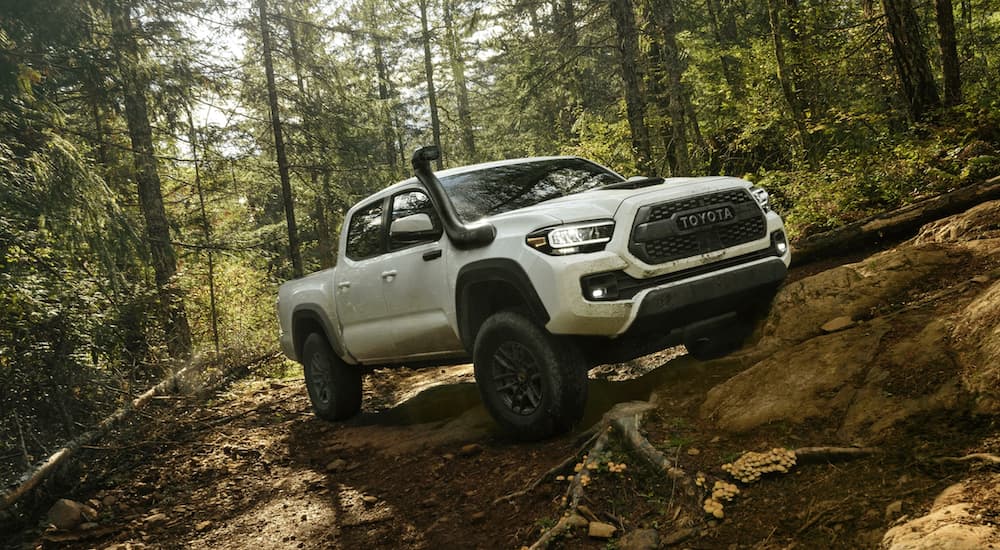Toyota’s recent announcement of a $383 million investment in American production operations is the latest in a series of major commitments made by the world’s largest automaker to the US manufacturing sector. It is not clear as of the time of writing whether this, and other multi-million-dollar investments by Toyota, are in addition to the previously announced $5.1 billion of spending planned for fuelling electrification efforts in US manufacturing operations, but the tap appears to be wide open in any case.
Show Them the Money
The $383 million focuses on developing the capacity to support hybrid vehicle powertrain manufacturing and, as such, is earmarked for division between four major sites in the south-central US: the Huntsville, AL engine plant, the Georgetown, KY manufacturing hub, the Troy, MO cylinder head plant and the Jackson, TN engine block plant.
Huntsville is getting the lion’s share, with $222 million going towards a new 4-cylinder engine line supporting both internal combustion engines (ICE) and hybrid electric vehicle (HEV) powertrains. The 114,000 sq.ft. expansion that is funded by the investment represents the plant’s sixth expansion since 2003. Thanks to this virtually continuous growth, the plant is currently producing 900,000 engines per year and represents a $1.5 billion investment in Alabama manufacturing. Extrapolation would imply that production will annually exceed 1 million engines following the completion of the project.
The smallest portion of funding, a mere pittance of $16 million, is going to the largest Toyota plant in the world, located at Georgetown, Kentucky. While the Huntsville expansion represents a 17% increase in local investment, this is a mere 0.2% of the $8.5 billion already sunk into the massive complex, currently producing the Camry, Avalon, RAV4 Hybrid, Lexus ES 300h, Lexus ES 350, and both 4 and 6-cylinder powertrains (fun fact: the site, which is nearly 3 miles across, is clearly visible on Google maps from such a height that Kansas City and Pittsburg both appear on-screen). This drop-in-the-bucket investment in the 600,000-unit-capacity powertrain facility is an add-on to a portion of a $461 million investment announced in October 2021, which included a new 2.4L turbocharged engine line, enabling planners to increase the flexibility of this new line to handle HEV engines as well.
The largest investment by relative capacity increase is being made in Troy, Missouri, where $109 million will be spent on new equipment for three separate lines to manufacture cylinder heads for the hybrid 4-cylinder engines. The plant is already capable of producing three million units a year after an investment of just over $450 million––this 24% increase could see production levels exceeding 3.7 million cylinder heads per year!
Finally, the remaining $36 million are earmarked for Jackson, Tennessee’s engine block plant, currently producing two million blocks a year for the $425 million invested there in total. This could be enough to produce the additional 150,000-or-so 4-cylinder engine blocks per year that Huntsville is planning to build with their investment noted above.
These aren’t the only recently announced powertrain investments Toyota has made, either. Just in February 2022, another $17 million was allocated to the Jackson plant to increase its hybrid transaxle case manufacturing capacity. That’s not to mention the plant that will assemble said transaxles in Buffalo, WV, a $2 billion facility receiving $73 million (on top of a 2021 expansion budget of $210 million) to boost its hybrid transaxle production capacity to 600,000 units annually and to start building 120,000 rear motor stators a year for electric motor production. The Buffalo plant is currently the only site in North America to build hybrid transaxles; Toyota seems committed to that, which is great news for the Mountain State.
Building More Combustion Engines in the Electric Age
The investments are a live-action demonstration of Toyota’s philosophy to build cars where it sells them and to support local supply chains as much as possible. Half of all Toyotas sold in the US are built within our borders––some of them, like the Tundra and Sienna, are even designed here! Whether this $383 million is an earmarked portion of the larger $5.1 billion plan or not remains to be seen, but in either case, it demonstrates that Toyota is committed to a future with a predominantly, if not fully, electrified lineup of vehicles built in the USA.
Announcements about increasing production capacity for combustion engines may seem at odds with the concept of electrification, but for Toyota, it is perfectly on-brand. While Toyota is the world’s leader in electrified (hybrid, plug-in hybrid, battery, and hydrogen fuel cell) powertrains and essentially cornered the hybrid vehicle market with the Prius, it had no general market EVs until the 2023 bZ4X was launched on April 12, 2022. CEO Akio Toyoda has been extremely public in his opposition to legislation that is, in his opinion, overly friendly to BEVs and unfriendly to other alternatives such as HEVs. As recently as 2021, director Shigeki Terashi said that the time to focus exclusively on EVs has yet to arrive, and Toyota conspicuously abstained from signing a declaration that they would phase out fossil fuel cars by 2040 at the 2020 U.N. Climate Conference in Scotland.
In essence, Toyota’s position is one of skepticism about the world’s ability to support a battery-powered automotive industry while we still depend almost entirely on lithium-ion technology. The ability to supply and process lithium, never mind doing so sustainably, at the scale needed to replace ICE vehicles at a 1:1 rate is a nigh-insurmountable challenge today. Over-committing to battery-powered EVs (BEVs) looks to Toyota like a reckless action due to the success of such a plan depending heavily on major changes outside of their control.
Therefore, although promising opportunities to strengthen the lithium supply chain do exist, Toyota has chosen to lean into what it does well––hybrid vehicles achieving 40-60 MPG at genuinely accessible prices. Of the 70 electrified models that Toyota will be marketing by 2025, fewer than 30 will be BEVs. Even Toyota Battery Manufacturing is focused on hybrids first, including a $1.29 billion plant in North Carolina where production of HEV and PHEV battery packs is slated to begin in 2025.
The bet is paying off. With gas prices at record highs of over $4 a gallon and electric vehicles still coming in with MSRPs well above average for a new car, many buyers are finding themselves priced out of the EV market and unable to bear the cost of ownership for ICE. As a result, Toyota hybrids remain the superior choice for most Americans. Because of this demand for hybrids and a strong supply chain, Toyota is now consistently challenging Ford and GM for the quarterly sales crown in the USA. The goal of selling 3.5 million electrified vehicles worldwide, on an annual basis, by 2030 seems completely feasible at this pace.
This means that HEVs and PHEVs remain a key component of Toyota’s strategy for achieving a 90% reduction in CO2 emissions from new vehicles by 2050. While Toyota’s brand-new bZ4X is the first of many BEVs to come, it is expected that the bulk of sales will remain hybrids for the foreseeable future. Rather than over-commit to an unsustainable supply requirement, Toyota’s choice is to become a carbon-neutral business through efforts to improve manufacturing and sourcing to the point that its minimized vehicle emissions are offset by the rest of the manufacturing cycle––which includes transforming all North American manufacturing operations to carbon-neutral status by 2035.
It Takes a Village
An exciting side effect of this rapid investment in a technological shift and extensive capacity expansion is the creation of high-quality manufacturing and engineering jobs throughout Toyota’s manufacturing operations in North America. Per Brian Krinock (senior vice president, vehicle plants, Toyota), “As we ramp up our plans for additional electrified products in North America, we must have the resources and talent in place to lead that transformation.” As such, Toyota Motors North America is adding 220 engineers to its Production Engineering Division to support the transformation to carbon-neutral manufacturing (in addition to the 1,750 jobs created by the North Carolina battery plant).
This announcement involves a 12% increase in the size of TMNA’s PE division, whose 1,800 engineers are stationed throughout North America (“only” 800 call the headquarters in Georgetown their home base). These engineers are not responsible for supporting the daily operations of North American plants, but rather act as liaisons between design and production, driving the transformation of plants to be ready for capacity increases and product design changes. They will be sorely needed at each of the changing and expanding facilities that are receiving Toyota’s billions of dollars of investments, and in the process, hundreds of young engineers will gain invaluable experience that will continue to benefit our economy for years to come.
The Winds of Change Blow Strong
Even Toyota, one of automotive manufacturing’s slowest makers to roll out major changes and new technologies, is getting on board the EV train, with evidence present that its lineup of 30 BEVs will even include Tacoma and FJ Cruiser-styled variants by 2030. However, this represents a fraction of Toyota’s electrified lineup plans, with 70 hybrid, fuel cell, and battery-powered models planned for 2030. The industry’s most conservative brand continues to temper its expectations and instead is leaning into what it does best––low-cost, high-quality hybrid vehicles––while reinventing its manufacturing processes to target carbon-neutral operations in a little more than a decade.
In the meantime, the investment and job creation that Toyota is executing throughout the south-central United States should be significant economic drivers for those regions. Although Toyota’s level of commitment to BEVs remains minimal, these announcements also make clear that by the time the industry pivot away from fossil fuels is complete, Toyota intends to remain at the top as the world’s number one automotive manufacturer.






